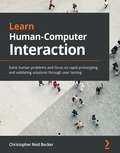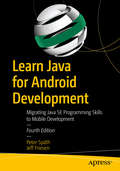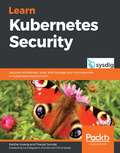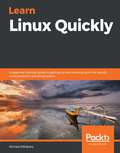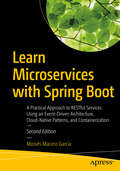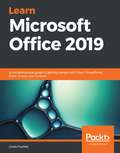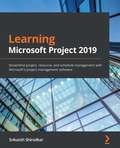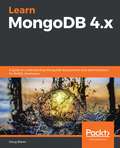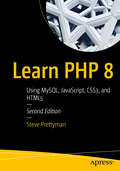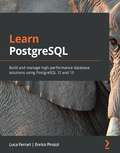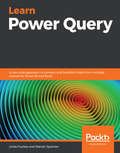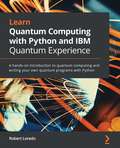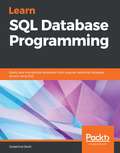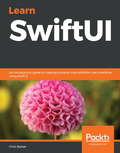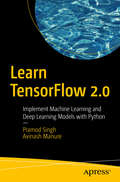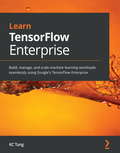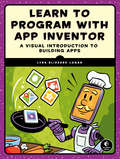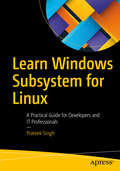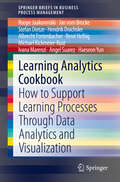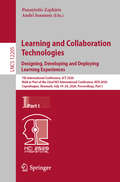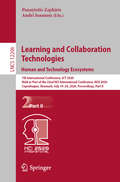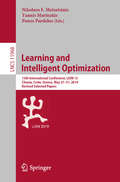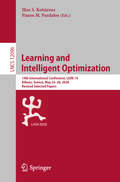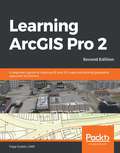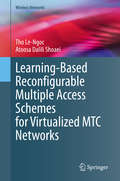- Table View
- List View
Learn Human-Computer Interaction: Solve human problems and focus on rapid prototyping and validating solutions through user testing
by Christopher Reid BeckerExplore fundamentals, strategies, and emerging techniques in the field of human-computer interaction to enhance how users and computers interact Key Features Explore various HCI techniques and methodologies to enhance the user experience Delve into user behavior analytics to solve common and not-so-common challenges faced while designing user interfaces Learn essential principles, techniques and explore the future of HCI Book Description Human-Computer Interaction (HCI) is a field of study that researches, designs, and develops software solutions that solve human problems. This book will help you understand various aspects of the software development phase, from planning and data gathering through to the design and development of software solutions. The book guides you through implementing methodologies that will help you build robust software. You will perform data gathering, evaluate user data, and execute data analysis and interpretation techniques. You'll also understand why human-centered methodologies are successful in software development, and learn how to build effective software solutions through practical research processes. The book will even show you how to translate your human understanding into software solutions through validation methods and rapid prototyping leading to usability testing. Later, you will understand how to use effective storytelling to convey the key aspects of your software to users. Throughout the book, you will learn the key concepts with the help of historical figures, best practices, and references to common challenges faced in the software industry. By the end of this book, you will be well-versed with HCI strategies and methodologies to design effective user interfaces. What you will learn Become well-versed with HCI and UX concepts Evaluate prototypes to understand data gathering, analysis, and interpretation techniques Execute qualitative and quantitative methods for establishing humans as a feedback loop in the software design process Create human-centered solutions and validate these solutions with the help of quantitative testing methods Move ideas from the research and definition phase into the software solution phase Improve your systems by becoming well-versed with the essential design concepts for creating user interfaces Who this book is for This book is for software engineers, UX designers, entrepreneurs, or anyone who is just getting started with user interface design and looking to gain a solid understanding of human-computer interaction and UX design. No prior HCI knowledge is required to get started.
Learn Java for Android Development: Migrating Java SE Programming Skills to Mobile Development
by Peter Späth Jeff FriesenGain the essential Java language skills necessary for using the Android SDK platform to build Java-based Android apps. This book includes the latest Java SE releases that Android supports, and is geared towards the Android SDK version 10. It includes new content including JSON documents, functional programming, and lambdas as well as other language features important for migrating Java skills to Android development. Android is still the world's most popular mobile platform and because this technology is still mostly based on Java, you should first obtain a solid grasp of the Java language and its APIs in order to improve your chances of succeeding as an effective Android apps developer. Learn Java for Android Development, 4th Edition helps you do that. Each of the book’s chapters provides an exercise section that gives you the opportunity to reinforce your understanding of the chapter’s material. Answers to the book’s more than 500 exercises are provided in an appendix. Once you finish, you will be ready to begin your Android app development journey using Java. What You Will LearnDiscover the latest Java programming language features relevant to Android SDK development Apply inheritance, polymorphism, and interfaces to Android development Use Java collections, concurrency, I/O, networks, persistence, functional programming, and data access in Android apps Parse, create, and transform XML and JSON documents Migrate your Java skills for mobile development using the Android platform Who This Book Is For Programmers with at least some prior Java programming experience looking to get into mobile Java development with the Android platform.
Learn Kubernetes Security: Securely orchestrate, scale, and manage your microservices in Kubernetes deployments
by Kaizhe Huang Pranjal Jumde Loris DegioanniSecure your container environment against cyberattacks and deliver robust deployments with this practical guide Key Features Explore a variety of Kubernetes components that help you to prevent cyberattacks Perform effective resource management and monitoring with Prometheus and built-in Kubernetes tools Learn techniques to prevent attackers from compromising applications and accessing resources for crypto-coin mining Book Description Kubernetes is an open source orchestration platform for managing containerized applications. Despite widespread adoption of the technology, DevOps engineers might be unaware of the pitfalls of containerized environments. With this comprehensive book, you'll learn how to use the different security integrations available on the Kubernetes platform to safeguard your deployments in a variety of scenarios. Learn Kubernetes Security starts by taking you through the Kubernetes architecture and the networking model. You'll then learn about the Kubernetes threat model and get to grips with securing clusters. Throughout the book, you'll cover various security aspects such as authentication, authorization, image scanning, and resource monitoring. As you advance, you'll learn about securing cluster components (the kube-apiserver, CoreDNS, and kubelet) and pods (hardening image, security context, and PodSecurityPolicy). With the help of hands-on examples, you'll also learn how to use open source tools such as Anchore, Prometheus, OPA, and Falco to protect your deployments. By the end of this Kubernetes book, you'll have gained a solid understanding of container security and be able to protect your clusters from cyberattacks and mitigate cybersecurity threats. What you will learn Understand the basics of Kubernetes architecture and networking Gain insights into different security integrations provided by the Kubernetes platform Delve into Kubernetes' threat modeling and security domains Explore different security configurations from a variety of practical examples Get to grips with using and deploying open source tools to protect your deployments Discover techniques to mitigate or prevent known Kubernetes hacks Who this book is for This book is for security consultants, cloud administrators, system administrators, and DevOps engineers interested in securing their container deployments. If you're looking to secure your Kubernetes clusters and cloud-based deployments, you'll find this book useful. A basic understanding of cloud computing and containerization is necessary to make the most of this book.
Learn Linux Quickly: A beginner-friendly guide to getting up and running with the world's most powerful operating system
by Ahmed AlKabaryLearn over 116 Linux commands to develop the skills you need to become a professional Linux system administrator Key Features Explore essential Linux commands and understand how to use Linux help tools Discover the power of task automation with bash scripting and Cron jobs Get to grips with various network configuration tools and disk management techniques Book Description Linux is one of the most sought-after skills in the IT industry, with jobs involving Linux being increasingly in demand. Linux is by far the most popular operating system deployed in both public and private clouds; it is the processing power behind the majority of IoT and embedded devices. Do you use a mobile device that runs on Android? Even Android is a Linux distribution. This Linux book is a practical guide that lets you explore the power of the Linux command-line interface. Starting with the history of Linux, you'll quickly progress to the Linux filesystem hierarchy and learn a variety of basic Linux commands. You'll then understand how to make use of the extensive Linux documentation and help tools. The book shows you how to manage users and groups and takes you through the process of installing and managing software on Linux systems. As you advance, you'll discover how you can interact with Linux processes and troubleshoot network problems before learning the art of writing bash scripts and automating administrative tasks with Cron jobs. In addition to this, you'll get to create your own Linux commands and analyze various disk management techniques. By the end of this book, you'll have gained the Linux skills required to become an efficient Linux system administrator and be able to manage and work productively on Linux systems. What you will learn Master essential Linux commands and analyze the Linux filesystem hierarchy Find out how to manage users and groups in Linux Analyze Linux file ownership and permissions Automate monotonous administrative tasks with Cron jobs and bash scripts Use aliases to create your own Linux commands Understand how to interact with and manage Linux processes Become well-versed with using a variety of Linux networking commands Perform disk partitioning, mount filesystems, and create logical volumes Who this book is for This book doesn't assume any prior Linux knowledge, which makes it perfect for beginners. Intermediate and advanced Linux users will also find this book very useful as it covers a wide range of topics necessary for Linux administration.
Learn Microservices with Spring Boot: A Practical Approach to RESTful Services Using an Event-Driven Architecture, Cloud-Native Patterns, and Containerization
by Moisés Macero GarcíaBuild Java-based microservices architecture using the Spring Boot framework by evolving an application from a small monolith to an event-driven architecture composed of several services. This revised book follows an incremental approach in teaching the structure of microservices, test-driven development, and common patterns in distributed systems such as service discovery, load balancing, routing, centralized logs, per-environment configuration, and containerization.This updated book now covers what's been added to the latest Spring Boot release, including support for the latest Java SE; more deep-dive knowledge on how Spring Boot works; testing with JUnit 5; changes in the Spring Cloud tools used for service discovery and load balancing; building Docker images using cloud-native buildpacks; a basic centralized logging solution; E2E traceability with Sleuth; centralized configuration with Consul; many dependency upgrades; support for Spring Data Neumann; and more.Author Moises Macero uses a pragmatic approach to explain the benefits of using this type of software architecture, instead of keeping you distracted with theoretical concepts. He covers some of the state-of-the-art techniques in computer programming, from a practical point of view. You’ll focus on what's important, starting with the minimum viable product but keeping the flexibility to evolve it.What You Will LearnBuild microservices with Spring BootDiscover architecture patterns for distributed systems such as asynchronous processing, eventual consistency, resilience, scalability, and moreUse event-driven architecture and messaging with RabbitMQMaster service discovery with Consul and load balancing with Spring Cloud Load BalancerRoute requests with Spring Cloud GatewayKeep flexible configurations per environment with Spring Cloud ConsulTrace every request from beginning to end with Sleuth and centralized loggingDeploy your microservices anywhere as Docker containersStart all the components in the microservice architecture with Docker ComposeWho This Book Is ForThose with at least some prior experience with Java programming. Some prior exposure to Spring Boot recommended but not required.
Learn Microsoft Office 2019: A comprehensive guide to getting started with Word, PowerPoint, Excel, Access, and Outlook
by Linda FoulkesGet to grips with the complete range of Office 2019 applications, explore solutions to common challenges, and discover best practices for working productively Key Features Explore MS Office to enhance productivity and boost your professional development Get up and running with the new and improved features in Microsoft Office 2019 Discover how to overcome common challenges when working with Office 2019 applications Book Description Learn Microsoft Office 2019 provides a comprehensive introduction to the latest versions of Microsoft Word, Excel, PowerPoint, Access, and Outlook. With the help of illustrated explanations, this Microsoft Office book will take you through the updated Office 2019 applications and guide you through implementing them using practical examples. You'll start by exploring the Word 2019 interface and creating professional Word documents using elements such as citations and cover pages, tracking changes, and performing mail merge. You'll then learn how to create impressive PowerPoint presentations and advance to performing calculations and setting up workbooks in Excel 2019, along with discovering its data analysis features. Later chapters will focus on Access 2019, assisting you in everything from organizing a database to constructing advanced queries. You'll then get up to speed with Outlook, covering how to create and manage tasks, as well as how to handle your mail and contacts effortlessly. Finally, you'll find solutions to commonly encountered issues and best practices for streamlining various workplace tasks. By the end of this book, you'll have learned the essentials of Office business apps and be ready to work with them to boost your productivity. What you will learn Use PowerPoint 2019 effectively to create engaging presentations Gain working knowledge of Excel formulas and functions Collaborate using Word 2019 tools, and create and format tables and professional documents Organize emails, calendars, meetings, contacts, and tasks with Outlook 2019 Store information for reference, reporting, and analysis using Access 2019 Discover new functionalities such as Translator, Read Aloud, Scalable Vector Graphics (SVG), and data analysis tools that are useful for working professionals Who this book is for Whether you're just getting started or have used Microsoft Office before and are looking to develop your MS Office skills further, this book will help you to make the most of the different Office applications. Familiarity with the Office 2019 suite will be useful, but not mandatory.
Learn Microsoft Project 2019: Streamline project, resource, and schedule management with Microsoft's project management software
by Srikanth ShirodkarExplore detailed explanations and examples to get up and running with the five phases of the project management lifecycle and integrate project management principles in a variety of projects Key Features Explore various algorithms and the latest features of MS Project to organize and keep track of your projects Understand Work Breakdown Structure (WBS) to improve productivity Apply real-world best practices and discover the tips, tricks, and pitfalls of schedule management Book Description Microsoft Project is one of the most popular project management tools for enterprises of all sizes thanks to its wide variety of features such as project scheduling, project budgeting, built-in templates, and reporting tools. Learning Microsoft Project 2019 will get you started with the basics and gradually guide you through the complete project life cycle. Starting with an overview of Microsoft Project 2019 and a brief introduction to project management concepts, this book will take you through the different phases of project management – initiation, planning, execution, control, and closure. You will then learn how to identify and handle problems related to scheduling, costing, resourcing, and work allocation. Understand how to use dynamic reports to create powerful, automated reports and dashboards at the click of a button. This Microsoft Project book highlights the pitfalls of overallocation and demonstrates how to avoid and resolve these issues using a wide spectrum of tools, techniques, and best practices. Finally, you will focus on executing Agile projects efficiently and get to grips with using Kanban and Scrum features. By the end of this book, you will be well-versed with Microsoft Project and have the skills you need to use it effectively in every stage of project management. What you will learn Create efficient project plans using Microsoft Project 2019 Get to grips with resolving complex issues related to time, budget, and resource allocation Understand how to create automated dynamic reports Identify and protect the critical path in your project and mitigate project risks Become well-versed with executing Agile projects using MS Project Understand how to create custom reports and make them available for future projects Who this book is for If you use Microsoft Office and are looking to use MS Project to manage your projects efficiently, this book is for you. Project managers or anyone interested in project management will also find this book useful. Basic knowledge of Windows UI and MS Office products is required.
Learn MongoDB 4.x: A guide to understanding MongoDB development and administration for NoSQL developers
by Doug BiererDesign, administer, and deploy high-volume and fault-tolerant database applications using MongoDB 4.x Key Features Build a powerful and scalable MongoDB database using real industry data Understand the process of designing NoSQL schema with the latest release of MongoDB 4.x Explore the ins and outs of MongoDB, including queries, replication, sharding, and vital admin tasks Book Description When it comes to managing a high volume of unstructured and non-relational datasets, MongoDB is the defacto database management system (DBMS) for DBAs and data architects. This updated book includes the latest release and covers every feature in MongoDB 4.x, while helping you get hands-on with building a MongoDB database app. You'll get to grips with MongoDB 4.x concepts such as indexes, database design, data modeling, authentication, and aggregation. As you progress, you'll cover tasks such as performing routine operations when developing a dynamic database-driven website. Using examples, you'll learn how to work with queries and regular database operations. The book will not only guide you through design and implementation, but also help you monitor operations to achieve optimal performance and secure your MongoDB database systems. You'll also be introduced to advanced techniques such as aggregation, map-reduce, complex queries, and generating ad hoc financial reports on the fly. Later, the book shows you how to work with multiple collections as well as embedded arrays and documents, before finally exploring key topics such as replication, sharding, and security using practical examples. By the end of this book, you'll be well-versed with MongoDB 4.x and be able to perform development and administrative tasks associated with this NoSQL database. What you will learn Understand how to configure and install MongoDB 4.x Build a database-driven website using MongoDB as the backend Perform basic database operations and handle complex MongoDB queries Develop a successful MongoDB database design for large corporate customers with complex requirements Secure MongoDB database systems by establishing role-based access control with X.509 transport-level security Optimize reads and writes directed to a replica set or sharded cluster Perform essential MongoDB administration tasks Maintain database performance through monitoring Who this book is for This book is a MongoDB tutorial for DevOps engineers, database developers, database administrators, system administrators and those who are just getting started with NoSQL and looking to build document-oriented databases and gain real-world experience in managing databases using MongoDB. Basic knowledge of databases and Python is required to get started with this DBMS book.
Learn PHP 8: Using MySQL, JavaScript, CSS3, and HTML5
by Steve PrettymanWrite solid, secure, object-oriented code in the new PHP 8. In this book you will create a complete three-tier application using a natural process of building and testing modules within each tier. This practical approach teaches you about app development and introduces PHP features when they are actually needed rather than providing you with abstract theory and contrived examples. In Learn PHP 8, programming examples take advantage of the newest PHP features; you’ll follow a learn-by-doing approach, which provides you with complete coding examples. “Do It” exercises in each chapter provide the opportunity to make adjustments to the example code. The end-of-chapter programming exercises allow you to develop your own applications using the algorithms demonstrated in the chapter. Each tier is logically and physically separated using object-oriented and dependency injection techniques, thus allowing independent tiers that can be updated with little or no effect on the other tiers. In addition to teaching good programming practices through OOP, there is a strong emphasis on creating secure code. As each chapter is completed, you’ll have the opportunity to design and create an application reinforcing the concepts learned. What You Will Learn Program PHP 8 web applications Use interfaces, containers, and platforms Apply modular programming Manage data objects and use MySQL and other databases Work with multi-functional and secure user interfaces Handle logging exceptions and more Who This Book Is For Those new to web development, specifically PHP programming. Also, this book can be useful to those who have some PHP/web development experience who are new to PHP 8.
Learn PostgreSQL: Build and manage high-performance database solutions using PostgreSQL 12 and 13
by Enrico Pirozzi Luca FerrariA comprehensive guide to building, managing, and securing scalable and reliable database and data warehousing applications using Postgres 12 and 13 Key Features Set up your database cluster and monitor, secure, and fine-tune it for optimal performance Learn the fundamentals of database management and implement client- and server-side programming using SQL and PL/pgSQL Explore useful tips to develop efficient PostgreSQL database solutions from scratch Book Description PostgreSQL is one of the fastest-growing open source object-relational database management systems (DBMS) in the world. As well as being easy to use, it's scalable and highly efficient. In this book, you'll explore PostgreSQL 12 and 13 and learn how to build database solutions using it. Complete with hands-on tutorials, this guide will teach you how to achieve the right database design required for a reliable environment. You'll learn how to install and configure a PostgreSQL server and even manage users and connections. The book then progresses to key concepts of relational databases, before taking you through the Data Definition Language (DDL) and commonly used DDL commands. To build on your skills, you'll understand how to interact with the live cluster, create database objects, and use tools to connect to the live cluster. You'll then get to grips with creating tables, building indexes, and designing your database schema. Later, you'll explore the Data Manipulation Language (DML) and server-side programming capabilities of PostgreSQL using PL/pgSQL, before learning how to monitor, test, and troubleshoot your database application to ensure high-performance and reliability. By the end of this book, you'll be well-versed with the Postgres database and be able to set up your own PostgreSQL instance and use it to build robust solutions. What you will learn Understand how users and connections are managed by running a PostgreSQL instance Interact with transaction boundaries using server-side programming Identify bottlenecks to maintain your database efficiently Create and manage extensions to add new functionalities to your cluster Choose the best index type for each situation Use online tools to set up a memory configuration that will suit most databases Explore how Postgres can be used in multi-instance environments to provide high-availability, redundancy, and scalability Who this book is for This Postgres book is for anyone interested in learning about the PostgreSQL database from scratch. Anyone looking to build robust data warehousing applications and scale the database for high-availability and performance using the latest features of PostgreSQL will also find this book useful. Although prior knowledge of PostgreSQL is not required, familiarity with databases is expected.
Learn Power Query: A low-code approach to connect and transform data from multiple sources for Power BI and Excel
by Linda Foulkes Warren SparrowDiscover how you can combine data from various sources to create data models to suit your business requirements with the help of this clear and concise guide Key Features Understand how Power Query overcomes the shortcomings of Excel Power Pivot in handling complex data Create customized dashboards and multi-dimensional reports using Power Query and Power BI Learn the Power Query M language and write advanced queries using custom functions Book Description Power Query is a data connection technology that allows you to connect, combine, and refine data from multiple sources to meet your business analysis requirements. With this Power Query book, you'll be empowered to work with a variety of data sources to create interactive reports and dashboards using Excel and Power BI. You'll start by learning how to access Power Query across different versions of Excel and install the Power BI engine. After you've explored Power Pivot, you'll see why Excel users find it challenging to clean data in Power Pivot and learn how Power Query can help to tackle the problem. The book will show you how to transform data using the Query Editor and write functions in Power Query. A dedicated section will focus on functions such as IF, Index, and Modulo, and creating parameters to alter query paths in a table. You'll also work with dashboards, get to grips with multi-dimensional reporting, and create automated reports. As you advance, you'll cover the M formula language in Power Query, delve into the basic M syntax, and write the M query language with the help of examples such as loading all library functions offline in Excel and Power BI. Finally, the book will demonstrate the difference between M and DAX and show how results are produced in M. By the end of this book, you'll be ready to create impressive dashboards and multi-dimensional reports in Power Query and turn data into valuable insights. What you will learn Convert worksheet data into a table format ready for query output Create a dynamic connection between an Access database and Excel workbook Reshape tabular data by altering rows, columns, and tables using various Power Query tools Create new columns automatically from filenames and sheet tabs, along with multiple Excel data files Streamline and automate reports from multiple sources Explore different customization options to get the most out of your dashboards Understand the difference between the DAX language and Power Query's M language Who this book is for This Power Query book is for business analysts, data analysts, BI professionals, and Excel users looking to take their skills to the next level by learning how to collect, combine, and transform data into insights using Power Query. Working knowledge of Excel and experience in constructing and troubleshooting Excel formulas and functions is expected.
Learn Quantum Computing with Python and IBM Quantum Experience: A hands-on introduction to quantum computing and writing your own quantum programs with Python
by Robert LoredoA step-by-step guide to learning the implementation and associated methodologies in quantum computing with the help of the IBM Quantum Experience, Qiskit, and Python that will have you up and running and productive in no time Key Features Determine the difference between classical computers and quantum computers Understand the quantum computational principles such as superposition and entanglement and how they are leveraged on IBM Quantum Experience systems Run your own quantum experiments and applications by integrating with Qiskit Book Description IBM Quantum Experience is a platform that enables developers to learn the basics of quantum computing by allowing them to run experiments on a quantum computing simulator and a real quantum computer. This book will explain the basic principles of quantum mechanics, the principles involved in quantum computing, and the implementation of quantum algorithms and experiments on IBM's quantum processors. You will start working with simple programs that illustrate quantum computing principles and slowly work your way up to more complex programs and algorithms that leverage quantum computing. As you build on your knowledge, you'll understand the functionality of IBM Quantum Experience and the various resources it offers. Furthermore, you'll not only learn the differences between the various quantum computers but also the various simulators available. Later, you'll explore the basics of quantum computing, quantum volume, and a few basic algorithms, all while optimally using the resources available on IBM Quantum Experience. By the end of this book, you'll learn how to build quantum programs on your own and have gained practical quantum computing skills that you can apply to your business. What you will learn Explore quantum computational principles such as superposition and quantum entanglement Become familiar with the contents and layout of the IBM Quantum Experience Understand quantum gates and how they operate on qubits Discover the quantum information science kit and its elements such as Terra and Aer Get to grips with quantum algorithms such as Bell State, Deutsch-Jozsa, Grover's algorithm, and Shor's algorithm How to create and visualize a quantum circuit Who this book is for This book is for Python developers who are looking to learn quantum computing and put their knowledge to use in practical situations with the help of IBM Quantum Experience. Some background in computer science and high-school-level physics and math is required.
Learn SQL Database Programming: Query and manipulate databases from popular relational database servers using SQL
by Josephine BushLearn everything you need to know to build efficient SQL queries using this easy-to-follow beginner's guide Key Features Explore all SQL statements in depth using a variety of examples Get to grips with database querying, data aggregate, manipulation, and much more Understand how to explore and process data of varying complexity to tell a story Book Description SQL is a powerful querying language that's used to store, manipulate, and retrieve data, and it is one of the most popular languages used by developers to query and analyze data efficiently. If you're looking for a comprehensive introduction to SQL, Learn SQL Database Programming will help you to get up to speed with using SQL to streamline your work in no time. Starting with an overview of relational database management systems, this book will show you how to set up and use MySQL Workbench and design a database using practical examples. You'll also discover how to query and manipulate data with SQL programming using MySQL Workbench. As you advance, you'll create a database, query single and multiple tables, and modify data using SQL querying. This SQL book covers advanced SQL techniques, including aggregate functions, flow control statements, error handling, and subqueries, and helps you process your data to present your findings. Finally, you'll implement best practices for writing SQL and designing indexes and tables. By the end of this SQL programming book, you'll have gained the confidence to use SQL queries to retrieve and manipulate data. What you will learn Install, configure, and use MySQL Workbench to restore a database Explore different data types such as string, numeric, and date and time Query a single table using the basic SQL SELECT statement and the FROM, WHERE, and ORDER BY clauses Query multiple tables by understanding various types of table relationships Modify data in tables using the INSERT, UPDATE, and DELETE statements Use aggregate functions to group and summarize data Detect bad data, duplicates, and irrelevant values while processing data Who this book is for This book is for business analysts, SQL developers, database administrators, and students learning SQL. If you want to learn how to query and manipulate SQL data for database administration tasks or simply extract and organize relevant data for analysis, you'll find this book useful. No prior SQL experience is required.
Learn SwiftUI: An introductory guide to creating intuitive cross-platform user interfaces using Swift 5
by Chris BarkerGet to grips with Apple's new SwiftUI framework for creating robust UIs for iOS and iPadOS using Swift programming Key Features Use SwiftUI for building dynamic apps for Apple devices from scratch Understand declarative syntax in cross-platform development and how states work within SwiftUI Learn to develop watchOS apps by reusing SwiftUI code Book Description SwiftUI is the new and powerful interface toolkit that lets you design and build iOS, iPadOS, and macOS apps using declarative syntax. It is a powerful way to develop the UI elements of applications, which would normally be tightly coupled to application logic. Learn SwiftUI will get you up to speed with the framework and cross-device UI development in no time. Complete with detailed explanations and practical examples, this easy-to-follow guide will teach you the fundamentals of the SwiftUI toolkit. You'll learn how to build a powerful iOS and iPadOS application that can be reused for deployment on watchOS. As you progress, you'll delve into UI and unit testing in iOS apps, along with learning how to test your SwiftUI code for multiple devices. The book will also show you how to integrate SwiftUI features such as data binding and network requests into your current application logic. By the end of this book, you will have learned how to build a cross-device application using the SwiftUI framework and Swift programming. What you will learn Explore the fundamentals of SwiftUI and compare it with existing UI frameworks Write SwiftUI syntax and understand what should and shouldn't be included in SwiftUI's layer Add text and images to a SwiftUI view and decorate them using SwiftUI's modifiers Create basic forms, and use camera and photo library functions to add images to them Understand the core concepts of Maps in iOS apps and add a MapView in SwiftUI Design extensions within your existing apps to run them on watchOS Handle networking calls in SwiftUI to retrieve data from external sources Who this book is for This SwiftUI book helps any mobile app developer looking to understand the fundamentals of the new SwiftUI framework along with the benefits of cross-device development. A solid understanding of iOS and macOS app development, along with some knowledge of the Swift programming language, will be beneficial. Basic programming knowledge is essential to grasp the concepts covered in the book effectively.
Learn TensorFlow 2.0: Implement Machine Learning and Deep Learning Models with Python
by Pramod Singh Avinash ManureLearn how to use TensorFlow 2.0 to build machine learning and deep learning models with complete examples. The book begins with introducing TensorFlow 2.0 framework and the major changes from its last release. Next, it focuses on building Supervised Machine Learning models using TensorFlow 2.0. It also demonstrates how to build models using customer estimators. Further, it explains how to use TensorFlow 2.0 API to build machine learning and deep learning models for image classification using the standard as well as custom parameters. You'll review sequence predictions, saving, serving, deploying, and standardized datasets, and then deploy these models to production. All the code presented in the book will be available in the form of executable scripts at Github which allows you to try out the examples and extend them in interesting ways.What You'll LearnReview the new features of TensorFlow 2.0Use TensorFlow 2.0 to build machine learning and deep learning models Perform sequence predictions using TensorFlow 2.0Deploy TensorFlow 2.0 models with practical examplesWho This Book Is ForData scientists, machine and deep learning engineers.
Learn TensorFlow Enterprise: Build, manage, and scale machine learning workloads seamlessly using Google's TensorFlow Enterprise
by KC TungThis book is for data scientists, machine learning developers or engineers, and cloud practitioners who want to learn and implement various services and features offered by TensorFlow Enterprise from scratch. Basic knowledge of the machine learning development process will be useful.
Learn to Program with App Inventor: A Visual Introduction to Building Apps
by Lyra LoganLearn to build mobile apps for Android devices with MIT App Inventor, a visual drag-and-drop programming language like Scratch.You've swiped and tapped your way through countless apps, but have you ever created one? Now you can, thanks to Learn to Program with App Inventor. In less than an hour, you'll be able to build and run your first app!App Inventor is a free software for making Android apps. All you need is a PC with an Internet connection to build your app, and a mobile phone for testing. You'll use a simple drag-and-drop interface, which minimizes errors and avoids too much typing. A certified App Inventor Master Trainer, Logan breaks down each project into logical steps, lists the components you'll need, and then shows you how to create screen designs, control program flow with conditionals and loops, and store data in variables and lists. Once you've tested the app on your phone, you can test what you learned with challenges at the end of each chapter.You'll build cool apps like: * Hi, World!: Use your voice to send a text message * Practice Makes Perfect: Rehearse a speech or dance routine with this video recording app * Fruit Loot: Catch randomly failing fruit in this exciting game * Beat the Bus: Track a friend's journey using location services and maps * Virtual Shades: Take a selfie, then try on some virtual sunglassesJoin the 6 million people who have tried App Inventor, and make the journey from app user to app inventor.
Learn Windows Subsystem for Linux: A Practical Guide for Developers and IT Professionals
by Prateek SinghBecome productive with seamless interoperability between Windows and the Linux subsystem, and understand the problems that Windows Subsystem for Linux (WSL) solves. Microsoft has pushed the boundaries of open source research with WSL and you don't want to miss this ride. You will learn keywords, definitions, new features, setup, and use cases around WSL, starting from downloading to setup to interoperability between Windows and Linux subsystems. You will understand the architecture of WSL and all the new features in WSL 2. This book includes wonderful use cases, including a dedicated chapter to how to start programming and web development on WSL, and the ability to use containerization solutions like Docker and Kubernetes. WSL is a great solution to work natively in a Linux environment from your Windows 10 machines. Modern applications demand integration of cross-platform tools, services and technologies. WSL makes life for developers and system administrators easy because it allows Linux applications to run on Windows without worrying about installing a Linux distribution on a traditional Virtual Machine. It is remarkable product with powerful functionality – get started with it using this book today. What You'll LearnReview the workings and internals of WSL and WSL2 Run Linux-based applications natively on WindowsEstablish your development environment in WSLBuild mixed experiences (Windows-Linux)Set up and manage WSL and supported distribution packages. Who This Book Is For Programmers, web developers and system administrators working on Windows and Linux environments who want to bridge the gap between operating systems by running a Linux as a subsystem on Windows to boost their overall productivity, performance and delivery.
Learning Analytics Cookbook: How to Support Learning Processes Through Data Analytics and Visualization (SpringerBriefs in Business Process Management)
by Roope Jaakonmäki Stefan Dietze Hendrik Drachsler Albrecht Fortenbacher René Helbig Michael Kickmeier-Rust Ivana Marenzi Angel Suarez Haeseon Yun Jan vom BrockeThis book offers an introduction and hands-on examples that demonstrate how Learning Analytics (LA) can be used to enhance digital learning, teaching and training at various levels. While the majority of existing literature on the subject focuses on its application at large corporations, this book develops and showcases approaches that bring LA closer to smaller organizations, and to educational institutions that lack sufficient resources to implement a full-fledged LA infrastructure. In closing, the book introduces a set of software tools for data analytics and visualization, and explains how they can be employed in several LA scenarios.
Learning and Collaboration Technologies. Designing, Developing and Deploying Learning Experiences: 7th International Conference, LCT 2020, Held as Part of the 22nd HCI International Conference, HCII 2020, Copenhagen, Denmark, July 19–24, 2020, Proceedings, Part I (Lecture Notes in Computer Science #12205)
by Panayiotis Zaphiris Andri IoannouThis two-volume set LNCS 12205 and LNCS 12206 constitutes the proceedings of the 7th International Conference on Learning and Collaboration Technologies, LCT 2020, held as part of the 22nd International Conference, HCI International 2020, which took place in Copenhagen, Denmark, in July 2020.The total of 1439 papers and 238 posters included in the 37 HCII 2020 proceedings volumes was carefully reviewed and selected from 6326 submissions.The papers in this volume are organized in the following topical sections: designing and evaluating learning experiences; learning analytics, dashboards and learners models; language learning and teaching; and technology in education: policies and practice. As a result of the Danish Government's announcement, dated April 21, 2020, to ban all large events (above 500 participants) until September 1, 2020, the HCII 2020 conference was held virtually.
Learning and Collaboration Technologies. Human and Technology Ecosystems: 7th International Conference, LCT 2020, Held as Part of the 22nd HCI International Conference, HCII 2020, Copenhagen, Denmark, July 19–24, 2020, Proceedings, Part II (Lecture Notes in Computer Science #12206)
by Panayiotis Zaphiris Andri IoannouThis two-volume set LNCS 12205 and LNCS 12206 constitutes the proceedings of the 7th International Conference on Learning and Collaboration Technologies, LCT 2020, held as part of the 22nd International Conference, HCI International 2020, which took place in Copenhagen, Denmark, in July 2020.The total of 1439 papers and 238 posters included in the 37 HCII 2020 proceedings volumes was carefully reviewed and selected from 6326 submissions.The papers in this volume are organized in the following topical sections: communication and conversation in learning; cognition, emotions and learning; games and gamification in learning; VR, robot and IoT in learning; and collaboration technology and collaborative learning. As a result of the Danish Government's announcement, dated April 21, 2020, to ban all large events (above 500 participants) until September 1, 2020, the HCII 2020 conference was held virtually.
Learning and Intelligent Optimization: 13th International Conference, LION 13, Chania, Crete, Greece, May 27–31, 2019, Revised Selected Papers (Lecture Notes in Computer Science #11968)
by Panos Pardalos Nikolaos F. Matsatsinis Yannis MarinakisThis book constitutes the thoroughly refereed pChania, Crete, Greece, in May 2019. The 38 full papers presented have been carefully reviewed and selected from 52 submissions. The papers focus on advancedresearch developments in such interconnected fields as mathematical programming, global optimization, machine learning, and artificial intelligence and describe advanced ideas, technologies, methods, and applications in optimization and machine learning.
Learning and Intelligent Optimization: 14th International Conference, LION 14, Athens, Greece, May 24–28, 2020, Revised Selected Papers (Lecture Notes in Computer Science #12096)
by Ilias S. Kotsireas Panos M. PardalosThis book constitutes the refereed post-conference proceedings on Learning and Intelligent Optimization, LION 14, held in Athens, Greece, in May 2020. The 37 full papers presented together with one invited paper have been carefully reviewed and selected from 75 submissions. LION deals with designing and engineering ways of "learning" about the performance of different techniques, and ways of using past experience about the algorithm behavior to improve performance in the future. Intelligent learning schemes for mining the knowledge obtained online or offline can improve the algorithm design process and simplify the applications of high-performance optimization methods. Combinations of different algorithms can further improve the robustness and performance of the individual components. Due to the COVID-19 pandemic, LION 14 was not held as a physical meeting.
Learning ArcGIS Pro 2: A beginner's guide to creating 2D and 3D maps and editing geospatial data with ArcGIS Pro, 2nd Edition
by Tripp CorbinCreate 2D maps and 3D scenes, analyze GIS data, and share your results with the GIS community using the latest ArcGIS Pro 2 features Key Features Get up to speed with the new ribbon-based user interface, projects, models, and common workflows in ArcGIS Pro 2 Learn how to visualize, maintain, and analyze GIS data Automate analysis and processes with ModelBuilder and Python scripts Book Description Armed with powerful tools to visualize, maintain, and analyze data, ArcGIS Pro 2 is Esri's newest desktop geographic information system (GIS) application that uses the modern ribbon interface and a 64-bit processor to make using GIS faster and more efficient. This second edition of Learning ArcGIS Pro will show you how you can use this powerful desktop GIS application to create maps, perform spatial analysis, and maintain data. The book begins by showing you how to install ArcGIS and listing the software and hardware prerequisites. You'll then understand the concept of named user licensing and learn how to navigate the new ribbon interface to leverage the power of ArcGIS Pro for managing geospatial data. Once you've got to grips with the new interface, you'll build your first GIS project and understand how to use the different project resources available. The book shows you how to create 2D and 3D maps by adding layers and setting and managing the symbology and labeling. You'll also discover how to use the analysis tool to visualize geospatial data. In later chapters, you'll be introduced to Arcade, the new lightweight expression language for ArcGIS, and then advance to creating complex labels using Arcade expressions. Finally, you'll use Python scripts to automate and standardize tasks and models in ArcGIS Pro. By the end of this ArcGIS Pro book, you'll have developed the core skills needed for using ArcGIS Pro 2.x competently. What you will learn Navigate the user interface to create maps, perform analysis, and manage data Display data based on discrete attribute values or range of values Label features on a GIS map based on one or more attributes using Arcade Create map books using the map series functionality Share ArcGIS Pro maps, projects, and data with other GIS community members Explore the most used geoprocessing tools for performing spatial analysis Create Tasks based on common workflows to standardize processes Automate processes using ModelBuilder and Python scripts Who this book is for If you want to learn ArcGIS Pro to create maps and, edit and analyze geospatial data, this ArcGIS book is for you. No knowledge of GIS fundamentals or experience with any GIS tool or ArcGIS software suite is required. Basic Windows skills, such as navigating and file management, are all you need.
Learning-Based Reconfigurable Multiple Access Schemes for Virtualized MTC Networks (Wireless Networks)
by Tho Le-Ngoc Atoosa Dalili ShoaeiThis book assists readers with understanding the key aspects, problems and solutions related to the design of proper Multiple Access Schemes for MTC (Machine-Type Communications) and IoT applications in 5G-and-beyond wireless networks. An overview of MTC applications and their traffic features are also provided. In addition, it presents a comprehensive review of MTC access schemes including orthogonal multiple access schemes (OMA), non-orthogonal multiple access schemes (NOMA), massive MIMO-based schemes and fast uplink grant approaches. It also proposes efficient and reconfigurable access schemes deploying machine learning and optimization techniques to address the main requirements of MTC networks. This book discusses potential research directions to further enhance the performance of MTC access schemes.Machine-type communications are expected to account for the dominant share of the traffic in future wireless networks. While in traditional wireless networks, designed for human-type communications, the focus is on support of large packet sizes in downlink, machine-type communication systems deal with heavy uplink traffic. This is due to the nature of the tasks performed by machine-type communication devices, which is mainly reporting measured data or a detected event. Furthermore, in these networks, using the virtualization framework, the network infrastructure can be shared between different applications for which providing isolation is of high importance. To support these unique characteristics of machine-type communications, proper access schemes need to be developed, which is the focus of this book.This book benefits advanced-level students studying computer science and electrical engineering as a secondary textbook and researchers working in this field. Engineers and practitioners interested in the challenges and practical solutions of integrating MTC in the cloud radio access network of 5G-and-beyond cellular systems will want to purchase this book as well.
